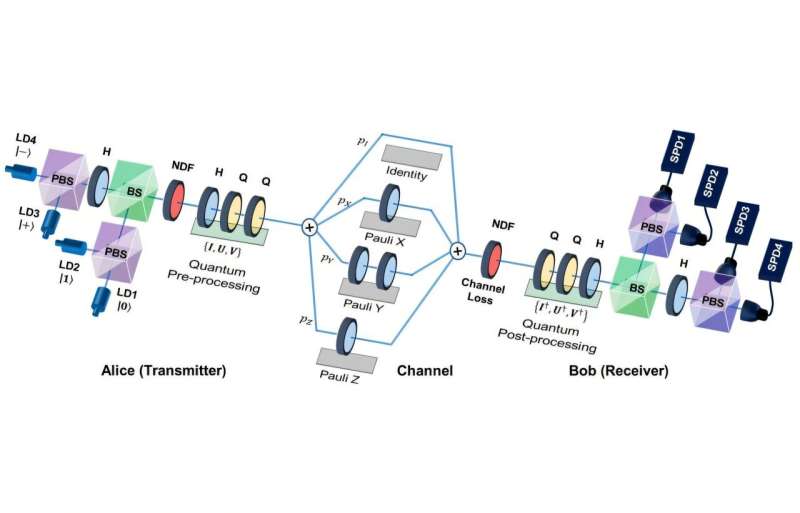Science
Korean Researchers Achieve Breakthrough in Quantum Key Distribution

Researchers from South Korea have made significant strides in quantum key distribution (QKD) by establishing a measurement protection (MP) theory that enables stable communication without the need for constant measurement corrections. This breakthrough, developed by the Electronics and Telecommunications Research Institute (ETRI) in collaboration with the Korea Advanced Institute of Science and Technology (KAIST), was experimentally verified and represents a major advancement in the field of quantum communication.
The research team successfully demonstrated that stable quantum communication can be achieved even in dynamic environments, such as those experienced by satellites, ships, and drones. Traditionally, quantum communication is susceptible to environmental factors, including weather and motion, which can disrupt the transmission of quantum states. The findings were published in the IEEE Journal on Selected Areas in Communications.
Overcoming Environmental Challenges
Quantum communication relies on the principles of quantum mechanics to transmit information securely. However, achieving stable communication in moving environments has proven to be a formidable challenge due to the rapid changes in channel conditions. The researchers’ work marks the first time that technical feasibility for stable quantum information exchange in such conditions has been established.
The study demonstrated that QKD can be executed with simple local operations, eliminating the need for extensive calibration of measurement devices that conventional protocols require whenever conditions fluctuate. According to the research, the implementation of the MP-based QKD system can increase the maximum allowable Quantum Bit Error Rate (QBER) by up to 20.7%. This enhancement means that as long as the error rate remains below this threshold, stable key distribution is achievable without additional measurement compensation.
To conduct their experiments, the researchers utilized a 100 MHz light source and a Vertical-Cavity Surface-Emitting Laser (VCSEL) to generate single-photon pulses. They created a long-distance free-space transmission environment, simulating various polarization noises to replicate challenging conditions. The successful verification of quantum transmission and measurement underscores the potential for reliable quantum communication across different noisy environments.
Implications for Future Communication Technologies
The implications of this research extend beyond theoretical advancements. With stable quantum key generation now achievable in various conditions, the technology is expected to find applications in diverse fields, including secure satellite-to-ground communication, drone operations, and maritime communications.
Lim Kyong Chun, a senior researcher in ETRI’s Quantum Communication Research Division, emphasized the need for further research into integrated photonic chips, stating that such advancements are crucial for expanding the QKD market. “More research is needed because there are many technical challenges to be overcome in the implementation of QKD systems based on integrated photonic chips,” he noted.
Additionally, ETRI has made progress in addressing the “Polarization-Dependent Loss” issue, a significant challenge for the practical application of QKD. This loss can hinder performance in integrated chip-based systems. ETRI researchers demonstrated that it can be compensated for using straightforward optical components, paving the way for the commercialization of compact and lightweight QKD equipment.
Youn Chun Ju, Assistant Vice President of ETRI’s Quantum Technology Research Division, remarked on the importance of this research, highlighting that it significantly enhances the flexibility of quantum cryptography. Looking ahead, he stated, “We will expand this to long-distance free-space link technology to establish the foundation for a global quantum network.”
As this research continues to evolve, the collaboration between ETRI and KAIST promises to reshape the landscape of quantum communication, making secure, reliable transmission possible even in complex environments.
-

 Health3 months ago
Health3 months agoNeurologist Warns Excessive Use of Supplements Can Harm Brain
-

 Health3 months ago
Health3 months agoFiona Phillips’ Husband Shares Heartfelt Update on Her Alzheimer’s Journey
-

 Science2 months ago
Science2 months agoBrian Cox Addresses Claims of Alien Probe in 3I/ATLAS Discovery
-

 Science1 month ago
Science1 month agoNASA Investigates Unusual Comet 3I/ATLAS; New Findings Emerge
-

 Science1 month ago
Science1 month agoScientists Examine 3I/ATLAS: Alien Artifact or Cosmic Oddity?
-

 Entertainment5 months ago
Entertainment5 months agoKerry Katona Discusses Future Baby Plans and Brian McFadden’s Wedding
-

 Science1 month ago
Science1 month agoNASA Investigates Speedy Object 3I/ATLAS, Sparking Speculation
-

 Entertainment4 months ago
Entertainment4 months agoEmmerdale Faces Tension as Dylan and April’s Lives Hang in the Balance
-

 World3 months ago
World3 months agoCole Palmer’s Cryptic Message to Kobbie Mainoo Following Loan Talks
-

 Science1 month ago
Science1 month agoNASA Scientists Explore Origins of 3I/ATLAS, a Fast-Moving Visitor
-

 Entertainment2 months ago
Entertainment2 months agoLewis Cope Addresses Accusations of Dance Training Advantage
-

 Entertainment3 months ago
Entertainment3 months agoMajor Cast Changes at Coronation Street: Exits and Returns in 2025









